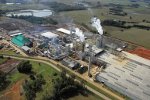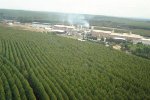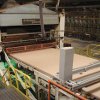Brazilian shake-up
3 December 2009The initial tremors shaking up the Brazilian panel industry, triggered largely by the global economic recession, saw the first stages of a long-delayed sector consolidation with the creation of two large new panel groups controlling a major slice of the Brazilian panel market.
Meanwhile, there were warnings of an aftershock later this year when fast expanding family-run panel producer Berneck SA revealed that it aims to acquire another player to form a third world-scale group in Brazil by the year’s end.
There is concensus locally that the market could sustain up to four big players.
Berneck boss Gilson Berneck has joined forces with a Brazilian private equity firm with access to foreign capital in his quest for a board producer with whom he can merge or form a joint venture. But, he warned, Berneck is determined to acquire the controlling interest in any panel partnership.
In the first move, the country’s top panel maker Duratex SA (see p38) agreed to merge with Brazil’s leading MDP (medium density particleboard) producer Satipel Industrial Ltda to form the biggest board manufacturer in the southern hemisphere. The giant group, retaining the name Duratex SA, will run seven continuous MDP and MDF lines and three for hardboard, with about four million m3/year capacity. It will hold 40% of the Brazilian market and has joint sales worth US$1.6bn.
Barely a month later, Chilean forest products giant Celulosa Arauco y Constitución SA finally pounced, snapping up Sonae Group’s isolated Brazilian panels-to-flooring business Tafisa Brasil SA in Piên, Paraná state in a US$227m deal.
Tafisa Brasil, which had been up for sale for some time, runs two continuous MDF lines with a joint 342,000m3/year capacity; a single 270,000m3/year continuous MDP line and a laminate flooring line. The move consolidates Arauco’s position in Brazil where its offshoot Placas do Paraná has MDF and MDP capacity in Paraná state of around 530,000m3/year.
Arauco, which still runs small-batch MDP lines in Curitiba that it inherited with Placas, will gain a modern continuous MDP line at Piên, while Tafisa, with no forest of its own, will benefit from Arauco’s growing national plantation reserves. Now, Placas is likely to close down the last single-opening MDP press lines in Curitiba, which have held the group back in Brazil’s particleboard market.
Since the global economic crisis hit Brazil, there has been a flurry of activity among panel makers who are keen to avoid being squeezed out of a shrinking market and determined to negotiate a role in the new-look panel industry of the future. Speculation is rife about who is currently in talks with whom on some fresh merger or joint venture.
What is clear is that the crisis caught the Brazilian industry unawares, just as many producers were completing ambitious capacity expansion schemes. The sudden downturn struck in September 2008 after Brazilian firms had enjoyed a five year market boom when MDF growth averaged 15% per year.
In the final quarter of last year and the first of 2009, panel manufacturers saw their sales volumes crash by 20%, with exports to the US and Europe particularly badly hit. Brazil’s domestic market also felt the recessionary draught, according to the country’s wood panel manufacturers association ABIPA.
Companies have been forced to cut their plants’ work shifts and slash production. Employees at some Brazilian panel plants have been laid off or reduced to carrying out essential maintenance work in recent months in the face of the market slump, the association said in July.
After a string of expansion projects for both MDF and MDP, panel producers were facing up to the prospect of continuing over-supply. The sector’s main customers in the Brazilian furniture industry also suffered badly from the international slowdown, not least in its southern zone at Bento Gonçalves where factories are focused on export business.
ABIPA has spent much of this year attempting to ease the plight of the recession- hit panel industry. Its efforts have focused chiefly on lobbying the Brazilian government for economic aid to bump-start sluggish consumer spending.
Early this year, as part of an economic stimulation package to counteract the worst effects of the slowdown, the government offered tax relief to customers of the car, construction and domestic appliances sectors. Since then, panel and furniture industry leaders have pressed the government to extend temporary relief from the industrial products tax (IPI) to their markets.
The Brazilian economy has benefited from a gradual fall in the country’s still high interest rates in the crisis period up to June 2009. Government aid to the banking sector also helped to release more credit in order to stimulate consumer sales.
Despite the effects of the crisis, there is still genuine confidence in some quarters in the longer term growth prospects for the domestic panel market. One executive talking up the market picture in July was Satipel’s commercial vice-president Roberto Sczachnowicz. “The Brazilian market has been better than foreign panel markets for the last year. It will continue to be so for the next couple of years,he told WBPI in São Paulo.
Mr Sczachnowicz, named as supply chain executive director of the ‘new’ Duratex SA, based his confidence on Brazil’s huge housing deficit and a government scheme to build a million new homes. Panel makers are backing a programme called ‘Minha Casa, Minha
Vida’ (‘My Home, My Life’) through which state-subsidised home loans will help lower-class Brazilians buy homes complete with fitted furniture.
“I see this [scheme] creating a lot of market opportunities for us....domestic consumption will keep growing in the years ahead,he said.
Brazil’s bulge in new panel capacity was clearly visible by mid-2009 as the last three big new MDP continuous press lines came on stream in Brazil’s southernmost state of Rio Grande do Sul.
In May, Masisa do Brasil Ltda launched its 750,000m3/year Dieffenbacher press line at Montenegro, while Satipel’s new 700,000m3/year Siempelkamp line launched three-shift production in mid-June. Meanwhile, the Isdra Group-owned firm Fibraplac Chapas de MDF Ltda started commercial output on its first MDP line, a 500,000m3/year Siempelkamp press unit, in July in Glorinha.
The recession, and consolidation moves, coincided with the end of Brazil’s latest cycle of big capacity expansion projects. But, there is one further scheme – the 350,000m3/year Dieffenbacher HDF line being built at Salto, São Paulo state, by hardboard and particleboard producer Eucatex SA (see p31). It is due on-stream early next year.
Meanwhile, industry sources are pointing to family-owned Fibraplac as an attractive prize in a hunt for a further merger or acquisition target. A relative newcomer to panel making, Fibraplac over six years has expanded rapidly to assemble a complex including two continuous Siempelkamp MDF and one MDP line with joint capacity of around one million m3/year. It also runs three low pressure melamine laminating lines at Glorinha.
Like several other Brazilian players, Fibraplac has temporarily abandoned further expansion projects because of the recession. In its case, there was a plan for a third MDF line on a second site further south near Rio Grande port. Other postponed plans include Duratex’s scheme for a giant one million m3/year MDP line in Itapetininga.
The panel makers have, though, glimpsed a shaft of light from the end of the crisis tunnel with some benefit being felt in the Brazilian market resulting from government intervention and the natural upturn felt during the second half of the year.
While the big boys of the sector struggle for power, there are still Brazil’s small panel newcomers, like the plywood converts (see p28), who are struggling for survival. The big question is, how will the panel industry’s disparate band of producers manage to share out the limited market cake? Casualties are inevitable.
But the hope is that, once the restructuring tremors have subsided, Brazil’s new-look industry will emerge leaner and fitter to meet the huge market challenges in South America’s biggest state and beyond.



